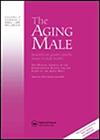The association between histological prostatitis and benign prostatic hyperplasia: a single-center retrospective study
IF 2.7
4区 医学
Q3 ENDOCRINOLOGY & METABOLISM
引用次数: 6
Abstract
Abstract Objective To investigate the relationship between histological prostatitis (HP) and clinical parameters related to benign prostatic hyperplasia (BPH) in male. Method The clinical data of 196 BPH patients who underwent transurethral resection of the prostate were collected. According to the results of hematoxylin-eosin (H&E) staining of prostate tissue, patients were divided into two groups: BPH with HP group and BPH without HP group. Differences in acute urinary retention (AUR), prostate volume (PV), serum sex hormones, lower urinary tract symptoms (LUTS) related parameters, and systemic inflammation indicators were compared between the two groups. SPSS software v.25 was used for statistical analysis. Results Compared with the BPH without HP group, the BPH with HP group had greater AUR rate, PV, total IPSS, and IPSS-storage in BPH with HP group (p < 0.05). However, there were no significant differences in IPSS-voiding, post-void residual volume, maximum urinary flow rate, serum sex hormones, and systemic inflammation indicators between the two groups (p > 0.05). Conclusions This study suggests that patients with HP have larger PV, more severe LUTS, and a higher risk of AUR. HP is closely related to BPH and may be a key factor in the occurrence and clinical progress of BPH.组织学前列腺炎与良性前列腺增生的关系:一项单中心回顾性研究
摘要目的探讨男性组织学前列腺炎(HP)与良性前列腺增生(BPH)相关临床参数的关系。方法收集经尿道前列腺电切术治疗前列腺增生196例的临床资料。根据前列腺组织苏木精-伊红(H&E)染色结果,将患者分为两组:BPH伴HP组和BPH不伴HP组。比较两组之间急性尿潴留(AUR)、前列腺体积(PV)、血清性激素、下尿路症状(LUTS)相关参数和全身炎症指标的差异。采用SPSS软件v.25进行统计分析。结果与无HP组相比,有HP组BPH患者的AUR率、PV、IPSS总量和IPSS存储量均高于无HP组(p 0.05)。结论本研究表明,HP患者PV更大,LUTS更严重,AUR风险更高。HP与BPH密切相关,可能是BPH发生和临床进展的关键因素。
本文章由计算机程序翻译,如有差异,请以英文原文为准。
求助全文
约1分钟内获得全文
求助全文
来源期刊

Aging Male
医学-泌尿学与肾脏学
CiteScore
6.40
自引率
3.80%
发文量
33
审稿时长
>12 weeks
期刊介绍:
The Aging Male , the official journal of the International Society for the Study of the Aging Male, is a multidisciplinary publication covering all aspects of male health throughout the aging process. The Journal is a well-recognized and respected resource for anyone interested in keeping up to date with developments in this field. It is published quarterly in one volume per year.
The Journal publishes original peer-reviewed research papers as well as review papers and other appropriate educational material that provide researchers with an integrated perspective on this new, emerging specialty. Areas of interest include, but are not limited to:
Diagnosis and treatment of late-onset hypogonadism
Metabolic syndrome and related conditions
Treatment of erectile dysfunction and related disorders
Prostate cancer and benign prostate hyperplasia.
 求助内容:
求助内容: 应助结果提醒方式:
应助结果提醒方式:


